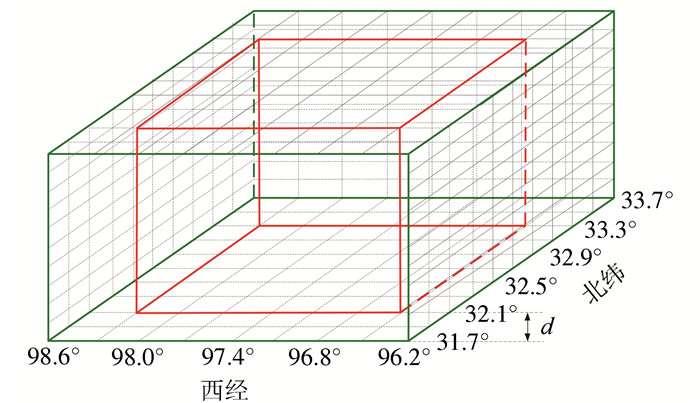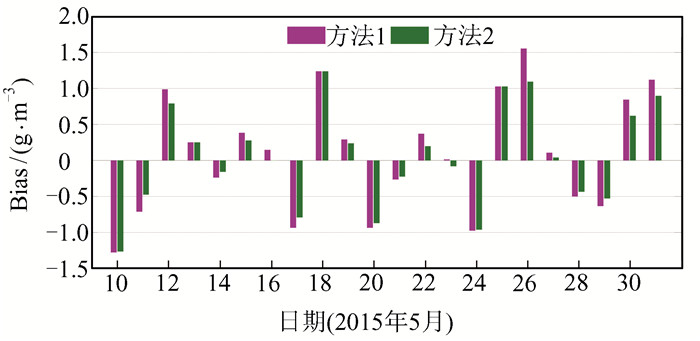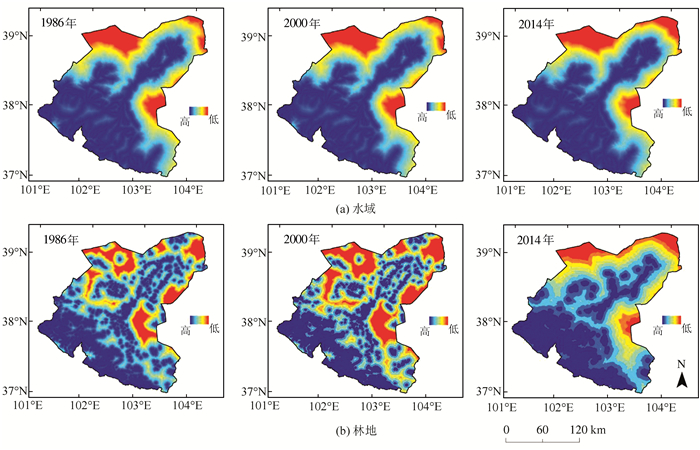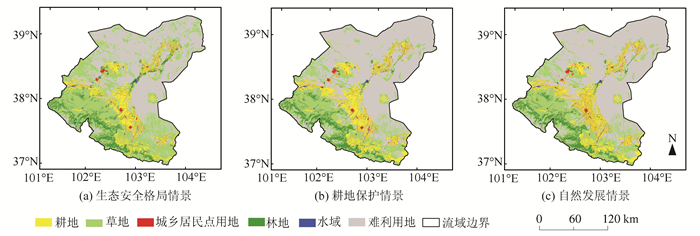Land Use Optimization Based on CLUE-S Model and Ecological Security Scenario in Shiyang River Basin
-
摘要: 以典型干旱内陆河流域石羊河为例,将GIS技术、最小累积阻力(minimum cumulative resistance,MCR)模型和CLUE-S(conversion of land use and its effects at small regional extent)模型应用到该流域土地利用优化配置研究中。通过景观安全格局理论构建土地利用生态安全格局,基于土地利用空间分布和驱动因子的定量关系,提出一种基于生态安全格局的土地利用情景模拟方法,借助1986年、2000年和2014年3期土地利用数据对石羊河流域生态安全格局情景、耕地保护情景和自然发展情景3种模式下2030年的土地利用结构和布局进行了优化配置,并对优化配置结果进行比较分析。结果表明,在生态安全情景下耕地有所减少,林地、草地和水域有较明显增加;耕地保护情景以土地开发和整治及宅基地还耕为主要目标,科学有效控制了建设用地规模,大力开发未利用地潜力;自然发展情景综合考虑了目前发展情况和宏观政策指导下各土地利用类型的数量及空间结构发展情况。综合考虑石羊河流域社会经济、生态及耕地保护等多方面的因素,研究结果认为耕地保护情景更为合理,其它两种情景可为耕地保护情景进行补充和局部修正。该结果可为石羊河流域土地利用总体规划和生态保护提供参考。Abstract: In this paper, GIS spatial analysis technologies, the minimum cumulative resistance model and CLUE-S model were applied to optimize the land use structure and the allocation in the Shiyang River Basin. Ecological security patterns were constructed to maintain the basic ecosystem services of Shiyang River Basin based on the theory of landscape security patterns and land use data collected in 1986, 2000, and 2014. Moreover, we set the land use change and spatial optimization allocation of the basin for the year 2030 under three development modes by MCR model and CLUE-S model, and then predicted the land use distribution under an ecological security pattern scenario, a farmland protection scenario, and a free development scenario. The results showed that the farmland decreased but woodland, grassland, and water body increased under an ecological security pattern scenario. Land use exploitation and renovation and homestead consolidation were the main objectives. The urban and residential landuse were controlled scientifically and effectively under a farmland protection scenario. In a free development scenario, the current free development situation and the government macro policy guidance were comprehensively considered and the quantity and spatial development were also taken into consideration. Comprehensive consideration of sustainable development in Shiyang river basin from the perspective of social, economic, ecological development, and farmland protection suggests that the free development scenario is relatively reasonable, and the other two scenarios can be a supplement for regional land optimal allocation.
-
Keywords:
- land use optimization /
- CLUE-S model /
- MCR model /
- ecological security pattern /
- Shiyang river basin
-
利用全球导航卫星系统(global navigation satellite system, GNSS)层析技术反演水汽已经成为获取水汽空间分布信息的重要手段之一,其高精度、全天候、高时空分辨率的优点在对暴雨等天气的监测和预报过程中得到了广泛应用[1-3]。自Bevis等[2]证明可以利用地基全球定位系统(global positioning system, GPS)获取水汽后,GNSS气象学的发展在国内外取得了许多成果[4-17]。
Bevis等[2]首先利用倾斜路径湿延迟对对流层进行层析,并基于欧洲中期天气预报中心(European Centre for Medium Range Weather Forecasts, ECMWF)预报产品对层析结果进行验证;于胜杰等[6]分析了不同约束条件对水汽反演结果的影响,并证明层析结果受测站间高差和先验信息精度影响较大。叶世榕等[7]结合数值积分参数化思想,提出了一种适用于层析的三维分布数值积分方法,结果证明该方法能够明显提高层析结果垂直廓线的精度;刘志赵等[8]提出了合理选择层析区域垂直高度和整体移动层析区域以增加射线利用率的方法,但该方法对数据利用率的提高有很大的局限性。何林等[3]讨论了代数重构算法在水汽层析中的各种问题,并对松弛因子和迭代终止条件的确定做了详细研究。
上述研究都是利用完整穿过层析区域的射线信息建立观测方程。由于受接收机和卫星特定几何位置的影响,很多卫星射线不可避免会从研究区域侧面穿出,在传统层析观测方程构建过程中因无法利用而被剔除。针对该情况,本文提出了一种附加辅助层析区域提高射线利用率的方法,使得从研究区域侧面穿出的信号也可以被利用。
1 GNSS层析原理
1.1 层析观测方程
在水汽反演过程中,倾斜路径水汽含量(slant water vapor, SWV)是建立层析观测方程中最重要的输入量,定义为从卫星到接收机沿卫星信号传播路径上总的水汽含量[8],其表达式为:
$$ {\rm{SWV}} = {10^{-6}}\cdot{\smallint _s}\rho \left( s \right){\rm{d}}s $$ (1) 式中,ρ(s)表示水汽密度(g/m3);s表示卫星到接收机的信号传播路径长度,ds表示沿s路径上每段路径元素的长度;SWV表示信号传播路径上的水汽含量。层析技术将研究区域分成若干立体网格,并假定网格内的水汽密度为一常数,可将式(1) 写成下面离散化的形式:
$$ {\rm{SW}}{{\rm{V}}^s} = \sum\limits_{i = 1}^n {(a_{_i}^{^s}\cdot{\rho _i})} $$ (2) 式中,ais表示卫星信号s在第i个网格内的截距;ρi表示第i个网格内的水汽密度;n表示层析区域划分的立体网格总数。
利用层析区域内接收机所观测到的卫星信号可组成观测方程:
$$ {\mathit{\boldsymbol{S}}_{l \times 1}} = {\mathit{\boldsymbol{A}}_{l \times n}}\cdot{\mathit{\boldsymbol{x}}_{n \times 1}} $$ (3) 式中,S表示l个SWV观测值组成的列向量;l表示层析区域内所有测站SWV观测值的总个数;A表示网格截距组成的系数矩阵;x表示待求网格水汽密度组成的列向量。
1.2 约束方程建立
由于层析区域内接收机数目有限,导致在给定的层析时段内有射线穿过的网格数目有限,因此,式(3) 中A是维数较大的稀疏离散矩阵,不能完全求解出x中所有的待求水汽密度值[8]。为了克服该法方程秩亏问题,通常需要加入先验约束信息对网格内的水汽密度进行约束[16-18]。基于水汽在空间呈连续分布及网格距离与水汽密度相关性成正比的特点,本文采用水平平滑约束建立水平约束方程[3]。基于水汽密度随高度呈指数递减的特点,采用指数函数构建垂直约束方程[18]。此外,将垂直路径上的水汽信息也加入到层析模型中;附加上述约束后可以得到传统方法的层析模型:
$$ \left( {\begin{array}{*{20}{c}} {\mathit{\boldsymbol{A}}_{_{l \times n}}^{^{{\rm{slant}}}}}\\ {\mathit{\boldsymbol{A}}_{_{m \times n}}^{^{{\rm{zenith}}}}}\\ {{\mathit{\boldsymbol{H}}_{l \times n}}}\\ {{\mathit{\boldsymbol{V}}_{l \times n}}} \end{array}} \right) \cdot {\mathit{\boldsymbol{x}}_{n \times 1}} = \left( \begin{array}{*{20}{c}} {\mathit{\boldsymbol{S}}_{l \times 1}}\\ {\mathit{\boldsymbol{P}}_{m \times 1}}\\ {{\bf{0}}_{l \times 1}}\\ {{\bf{0}}_{l \times 1}} \end{array} \right) $$ (4) 式中,Al×nslant为斜方向投影函数;Am×nzenith为天顶方向投影函数;Pm×1为m个测站的天顶方向水汽含量组成的列向量;H和V分别表示水平约束和垂直约束的系数矩阵。基于联合代数重构算法(multiplicative algebraic reconstruction technique, MART)能够短时间内快速收敛的特点[17],对于式(4) 利用MART算法求解。
2 附加辅助层析区域反演水汽的方法
2.1 附加辅助层析区域反演水汽思想
受接收机和卫星星座特定几何位置分布的影响,层析区域内总有很多射线信号会从研究区域侧面穿出,被当作无效信息剔除。这不仅降低了观测数据的利用率,也会对反演结果造成一定的影响。
为了解决上述问题,本文提出了一种附加辅助层析区域反演水汽的方法。该方法的核心思想是在经度、纬度方向上对原有层析区域进行延伸,直至扩大后的层析区域能够确保原层析区域内所有测站一定高度截止角之内的卫星射线都能完整穿过扩大后的层析区域。对扩大后的层析区域进行水汽反演,可得到原层析区域内各网格的水汽密度初值。将此初值用于迭代并结合传统方法对层析区域的水汽进行再次反演,得到更高质量的层析结果。需要指出的是,于胜杰等[6]通过多次水汽层析实验证明,先验信息对不同GPS网中的作用差异较大。当层析区域内GPS测站间的相对高差较小时,其层析方程的系数矩阵奇异程度较为严重,因此初值信息对层析结果有很大影响;扩大层析区域范围后,扩大层析区域内的水汽参数也会增多,其水汽密度层析结果的精度和可靠性可以稍差,因为只将其结果作为初值进行下一步运算。
2.2 附加辅助层析区域具体实现过程
为了便于表达,将需要研究的层析区域(如图 1中较小的红色网格区域所示)在水平方向上经过一定的延伸形成的新区域称为辅助层析区域(如图 1中较大的绿色网格区域所示),其垂直高度保持不变。
本文提出的水汽反演方法实现过程如下。
1) 确定要延伸的水平距离,如图 1中d所示。根据层析区域的垂直高度和卫星截止高度角,以研究区域的边界为起点(假定右侧站在研究区域边界上)确定出在经度和纬度方向上要延伸的水平范围,以确保层析区域内所有测站在一定卫星高度截止角范围内的卫星射线都能够完整穿过该辅助研究区域。如图 2所示,假定进行水汽层析时利用的卫星截止高度角为α,层析区域的垂直高度为H(单位为km),在层析区域边界上有一测站P,其有一条α度角的边界射线信号S,则可以通过式(5) 计算出需要延伸的水平距离d:
$$ d = H/{\rm{tan}}\alpha $$ (5) 2) 利用原层析区域内所有测站观测到的卫星高度角大于α的射线信息建立辅助研究区域(如图 1中较大的绿色区域)的辅助观测方程,然后附加各种约束后得到辅助层析区域的层析模型。
3) 通过SVD全科分解法[20]对第2) 步建立的辅助层析模型求解,得到辅助层析区域内每个网格的水汽密度估值。然后只选取原层析区域网格(如图 1中较小的红色区域内的网格)所在位置的水汽密度估值作为初值用于下一步解算。
4) 基于传统方法利用完整穿过层析区域(如图 1中较小的红色区域)的信号射线建立观测方程,并附加约束条件得到研究区域的层析模型,如式(4) 所示。
5) 基于MART方法对层析区域的层析模型进行解算,将第3) 步中得到的水汽密度作为MART方法解算的初值进行一步修正,得到层析结果的最终解。
3 方法有效性检验
利用无线电探空仪获取的数据能够得到垂直方向上精确的水汽密度信息[3, 14],通常将其作为检验层析技术反演水汽结果的标准。本文将均方根误差(root mean square, RMS)、偏差(Bias)和平均绝对偏差(MAE)作为检验本文提出方法反演水汽精度的指标。
3.1 实验数据及层析策略
选取美国德克萨斯地区运行参考站(Continuously Operation Reference Stations, CORS)网中13个GPS测站(如图 3中▲所示)的观测数据进行层析实验,各测站具体站名和相关信息如表 1所示,选取时间为2015-05-10~2015-05-31共22 d,需要说明的是在此后的数据分析均是基于该数据进行的。其中,在层析区域有一个72 249探空站(radiosonde station),如图 3中·所示,该探空站每天在UTC 00:00和12:00发射探空气球获取数据,本文将该探空数据计算结果作为检核层析结果的标准。
表 1 美国得克萨斯州地区CORS网中使用的测站信息Table 1. Information of Stations Using CORS Network in Texas测站名 纬度/(°) 经度/(°) 高/km 接收机类型 TXCO 33.150 0 96.616 7 161.893 TRIMBLE NETR5 TXDA 32.783 3 96.666 7 160.642 TRIMBLE NETR9 TXDC 33.233 3 97.600 0 255.282 TRIMBLE NETR5 TXDE 33.200 0 97.150 0 178.789 TRIMBLE NETR5 TXES 32.366 7 96.850 0 163.749 TRIMBLE NETR9 TXGR 32.233 3 97.750 0 177.482 TRIMBLE NETR5 TXJA 33.183 3 98.133 3 326.043 TRIMBLE NETR5 TXKE 32.400 0 97.316 7 227.949 TRIMBLE NETR5 TXMW 32.800 0 98.133 3 246.447 TRIMBLE NETR5 TXSG 32.850 0 97.333 3 181.667 TRIMBLE NETR5 TXST 32.216 7 98.166 7 376.574 TRIMBLE NETR5 TXWE 32.750 0 97.816 7 337.386 TRIMBLE NETR9 ZFW1 32.816 7 97.050 0 155.193 NOV WAASGII 本文实验所选取的研究范围(如图 3中红色区域范围所示):纬度方向为32.1°N~33.3°N,分辨率为0.2°;经度方向为96.5°W~98.3°W,分辨率为0.3°;垂直方向为0~10 km,分辨率为1 km;研究区域共有6×6×10个网格。在进行层析时,选取的卫星截止高度角为10°,因此根据§2.2部分可以确定出辅助层析区域的范围(如图 3整个区域范围所示),以确保原层析区域内的13个接收机在10°~90°卫星截止高度角之间的所有射线信号都能完整穿过辅助研究区域;其具体范围:纬度31.7°N~33.7°N,经度96.2°W~98.6°W;辅助层析区域内网格个数为10×8×10。
实验中采用两种方法获取原层析区域内的水汽信息。
方法1 采用传统方法建立的层析模型反演水汽,即式(4) 建立的层析模型;
方法2 利用本文提出的层析方法反演水汽,即利用§2.2给出的解算步骤。
GAMIT (v10.5) 软件对GPS数据处理的天顶对流层延迟参数估计精度优于±1 cm[21],结合气象参数得到的PWV只有±1.5 mm,因此基于投影函数得到的SWV其精度足以满足水汽层析的需求。本文在利用GAMIT(v10.5) 软件[22]对实验数据进行处理时,为了消除局域网中各测站对流层参数相关性的影响,引入了INEG、NIST、NILB和PIE1 4个网外IGS辅助站参与解算[23]。
3.2 射线利用及射线穿过网格数分析
基于§3.1给出的两种方法,统计了层析时段内每天一次不同方法射线利用情况及与有射线穿过的网格个数(图 4);表 2给出了每天的平均统计信息。由图 4和表 2可以看出,方法2在射线使用条数和有射线穿过的网格数方面均大于方法1。通过计算,本文提出的方法使射线的平均利用率提高了18.94%。
表 2 两种方法射线利用情况及有射线穿过网格数统计信息Table 2. Statistical Information of the Number of Signal Used and Voxels Crossed by Rays方法 信号使用条数 信号穿过网格数 均值 最大值 最小值 均值 最大值 最小值 1 676 786 655 392 307 277 2 803 905 776 399 312 284 3.3 水汽反演精度检验
为了验证本文提出方法反演水汽结果的精度,对层析时段内每天两个观测历元(UTC 00:00和12:00) 不同方法反演的水汽结果进行对比。首先利用两种方法反演水汽得到探空站所在位置上相应历元的水汽密度估值,然后与探空站数据计算结果进行对比,统计得到每天的均方根误差、偏差和平均绝对误差(见图 5~图 7);表 3给出了每天的平均统计结果。
表 3 与探空数据对比22天的统计信息/(g·m-3)Table 3. Statistical Information Compared with Radiosonde Data for 22 Days/(g·m-3)方法 RMS Bias MAE 均值 最大值 最小值 均值 最大值 最小值 均值 最大值 最小值 1 1.78 2.93 0.54 0.11 1.58 -1.29 1.26 2.14 0.42 2 1.52 2.75 0.42 0.02 1.25 -1.27 1.04 1.97 0.34 由图 5~图 7可以看出,方法2的RMS、Bias和MAE均优于方法1;由表 3也可以看出,方法2的平均RMS、Bias和MAE均小于方法1。这说明,本文提出的利用辅助层析区域提高射线利用率反演水汽的方法其精度要优于传统方法。
3.4 水汽密度廓线对比
为了进一步分析本文提出的方法反演水汽密度在垂直方向上的分布情况,对层析时段内的层析结果进行统计,得到探空站所在位置上不同高度的平均水汽密度值,并与探空站计算的结果进行对比(图 8)。图 8(a)给出了两种方法与无线电探空仪对比水汽密度随高度的变化情况,图 8(b)给出了不同高度上的RMS。
由图 8(a)可以看出,方法2反演水汽密度得到的廓线信息在不同高度上与探空数据计算结果具有更好的一致性。由图 8(b)也可以看出,方法2反演水汽的精度其垂直分布也优于传统方法。这进一步说明,通过本文方法,实现了在研究区域侧面穿出的射线信息对层析区域水汽反演的贡献,提高了水汽反演结果的质量。
4 结语
传统层析方法中,从研究区域侧面穿出的射线信息因无法被使用而导致了观测数据的浪费。针对该情况,本文提出了一种附加辅助层析区域提高射线利用率的水汽反演方法。基于美国得克萨斯地区的CORS网2015-05-10~2015-05-31共22天的观测数据进行实验,验证了本文提出方法反演水汽的有效性及精度。
实验结果表明, 本文提出的方法能够充分利用从研究区域侧面穿出的射线信息,实现了这些射线信息对最终层析结果的贡献。通过与探空数据计算结果对比发现,利用本文提出的方法得到的水汽结果有很大的改善,其RMS的改善率为14.6%,Bias的改善率为27.3%,MAE的改善率为17.5%。这说明本文提出的方法反演的水汽密度信息在RMS、Bias和MAE等方面均优于传统方法。
-
表 1 2014年不同土地利用类型的Logistic回归系数分布
Table 1 The Logistic Regression Coefficient Distribution of Different Land Use Types in 2014
土地利用变化驱动因子 耕地 林地 草地 建设用地 未利用地 因子说明 ROC值 0.773 0.790 0.687 0.844 0.890 - 常数 2.091 -0.102 0.196 1.434 -4.069 - 生态功能分区/km2 -0.002 0.003 0.001 -0.003 -0.403 生态功能区划图数字化后转栅格 土地利用功能分区/ km2 0.358 0.023 0.003 0.000 -0.001 土地利用(三大类)现状图转为栅格 林地面积/ km2 -0.024 -0.001 0.385 -0.015 - 生态功能区划图提取结果 高程/m -0.082 0.010 0.004 -0.003 0.030 采用DEM数据 坡度/(°) 0.015 0.028 0.016 -2.089 -1.023 利用DEM计算得到 年平均降雨量/mm 0.030 6 0.044 1 0.032 0 - -0.026 7 气象站点数据插值为栅格数据 年平均温度/(℃) -0.010 0.054 2 -0.005 6 - -0.000 8 插值为栅格数据 植被覆盖度/% 0.038 0.224 5 1.886 0.024 -0.003 利用NDVI计算得到 人口密度/(人·km2) 0.443 0.103 0.042 0 0.067 -0.066 以乡为统计单元,插值为栅格数据 人均收入/(人·元) 0.098 0.012 -0.010 0.033 -2.333 以乡为统计单元,插值为栅格数据 国内生产总值/104元 0.003 0.002 0.001 1.234 -1.888 以乡为统计单元,插值为栅格数据 从业总人数/人 0.007 0.003 0.003 5 0.359 1 -0.003 以镇为统计单元,插值为栅格数据 粮食产量/t 2.391 -0.337 -0.022 -0.004 0.003 以乡为统计单元,插值为栅格数据 人均耕地占有量/ km2 0.013 0.001 0.001 0.003 -0.009 以乡为统计单元,插值为栅格数据 距城镇和农村居民点距离/m 0.005 -0.001 - -0.004 -0.001 量算每个像元的中心距村、镇距离 距河流距离/m -0.003 -0.001 -0.004 -0.024 -1.334 量算每个像元的中心距河流距离 距铁路和高速道路距离/m 0.001 -0.004 0.003 -0.008 -0.009 量算每个像元的中心距高等级公路距离 距省道和县乡道的距离/m 0.007 -0.001 0.002 -0.001 -0.003 量算每个像元的中心距较低等级公路距离 表 2 土地利用优化配置分区统计表
Table 2 Zonal Statistic Table of Landuse Optimization Configuration
优化分区 面积/km2 百分比/% 主要分布区域 生态保护核心区 10 033.76 24.12 天祝县西北部,凉州区南部和肃南县东部;金川区中心城区周边及民勤县城周边乡镇。 重点优化配置区 9 357.42 22.49 凉州区大部分乡镇、古浪县西部、永昌县中北部、金川区城区周边和民勤县城周边大部分乡镇。 潜在优化配置区 7 664.19 18.42 古浪县中部和东部大部分地区、永昌县北部部分乡镇和民勤县靠近沙漠边缘的少部分乡镇。 生态保护重点区 6 895.50 16.58 民勤县沙漠与绿洲交汇地带、沿民勤县城周边大部分地区古浪县北部、凉州区东部和金川区北部部分乡镇。 生态恢复关注区 4 248.09 10.21 绝大部分分布在民勤沙漠与裸地边缘地带,凉州区和金川区靠近沙漠去也有少量分布。 生态综合治理区 3 401.04 8.18 民勤县北部的沙漠腹地和凉州区东部有少量分布。 表 3 2030年不同情景方案土地利用结构变化与比较/km2
Table 3 Landuse Structure Change and Comparisons Based on Different Simulations in 2030/ km2
土地利用类型 生态安全情景 耕地保护情景 自然发展情景 2014年现实情景 与生态安全比较的变化值 变化率 耕地 5 911.48 6 612.42 6 050.25 6 225.89 -314.41 -5.32 林地 4 207.64 3 012.85 2 212.68 2 783.47 1 424.17 33.85 草地 12 325.72 10 925.17 10 323.90 10 840.59 1 485.13 12.05 城乡居民点用地 543.74 522.80 566.95 516.35 27.40 5.04 水体 310.61 299.76 280.53 216.79 93.82 30.21 未利用地 18 301.18 20 227.37 22 166.06 21 017.29 -2 716.11 -14.84 -
[1] 刘彦随, 郑伟元.中国土地可持续利用论[M].北京:科学出版社, 2008 Liu Yansui, Zheng Weiyuan. Sustainable Land Use of China[M]. Beijing:Science Press, 2008.
[2] 徐昔保, 杨桂山, 张建明.兰州市城市土地利用优化研究[J].武汉大学学报·信息科学版, 2009, 34(7):878-881 http://www.cnki.com.cn/Article/CJFDTOTAL-WHCH200907028.htm Xu Xibao, Yang Guishan, Zhang Jianming.Urban Land Use Optimization in Lanzhou, China[J]. Geomatics and Information Science of Wuhan University, 2009, 34(7):878-881 http://www.cnki.com.cn/Article/CJFDTOTAL-WHCH200907028.htm
[3] 谭永忠. 县级尺度土地利用变化驱动机制及空间格局变化模拟研究[D]. 杭州: 浙江大学, 2004 http://cdmd.cnki.com.cn/Article/CDMD-10335-2004043832.htm Tan Yongzhong. Land Use Driving and Spatial Temporal Change of Simulation Based on Country Level[D].Hangzhou:Zhejiang University, 2004 http://cdmd.cnki.com.cn/Article/CDMD-10335-2004043832.htm
[4] 贺秋华. 江苏滨海土地利用/覆盖变化及其生态环境效应研究[D]. 南京: 南京师范大学, 2011 http://cdmd.cnki.com.cn/article/cdmd-10319-1011187678.htm He Qiuhua. Coastal Land Use/Land Cover Change and Its Ecological Environment Effect Research in Jiangsu[D]. Nanjing:Nanjing Normal University, 2011 http://cdmd.cnki.com.cn/article/cdmd-10319-1011187678.htm
[5] 郭碧云, 张广军.基于GIS和Markov模型的内蒙古农牧交错带土地利用变化[J].农业工程学报, 2009, 25(12):291-298 doi: 10.3969/j.issn.1002-6819.2009.12.051 Guo Biyun, Zhang Guangjun. Land Use Change in Farming Pastoral Region of Inner Mongolia Based on GIS and Markov Model[J]. Transactions of the Chinese Society of Agricultural Engineering(Transactions of the CSAE), 2009, 25(12):291-298 doi: 10.3969/j.issn.1002-6819.2009.12.051
[6] 刘彦随, 陈百明.中国可持续发展问题与土地利用/覆被变化研究[J].地理研究, 2002, 21(3):324-330 http://www.cnki.com.cn/Article/CJFDTOTAL-DLYJ200203006.htm Liu Yansui, Chen Baiming. The Study Framework of Land Use/Cover Change Based on Sustainable Development in China[J]. Geographical Research, 2002, 21(3):324-330 http://www.cnki.com.cn/Article/CJFDTOTAL-DLYJ200203006.htm
[7] 刘纪远, 刘明亮, 庄大方, 等.中国近期土地利用变化的空间格局分析[J].中国科学:地球科学, 2002, 32(12):1031-1040 http://www.cnki.com.cn/Article/CJFDTOTAL-JDXK200212007.htm Liu Jiyuan, Liu Mingliang, Zhuang Dafang, et al. Analysis on the Spatial Pattern of Recent Land Use Changes in China[J]. Scientia Sinica (Terrae), 2002, 32(12):1031-1040 http://www.cnki.com.cn/Article/CJFDTOTAL-JDXK200212007.htm
[8] 刘耀林, 赵翔, 刘殿锋.土地利用优化配置人工免疫并行决策支持系统[J].武汉大学学报·信息科学版, 2014, 39(2):166-171 http://www.cnki.com.cn/Article/CJFDTOTAL-WHCH201402009.htm Liu Yaolin, Zhao Xiang, Liu Dianfeng. A Parallel Decision Support System for Land-Use Allocation Optimization Based on Artificial Immune System[J]. Geomatics and Information Science of Wuhan University, 2014, 39(2):166-171 http://www.cnki.com.cn/Article/CJFDTOTAL-WHCH201402009.htm
[9] Marulla J, Pinob J, Tello E, et al. Social Metabolism, Landscape Change and Landuse Planning in the Barcelona Metropolitan Region[J].Land Use Policy, 2010, 27(2):497-510 doi: 10.1016/j.landusepol.2009.07.004
[10] Stewart T J, Janssen R, Herwijnen M V. A Genetic Algorithm Approach to Multi-objective Land Use Planning[J].Computers and Operations Research, 2004, 31(14):2293-2313 doi: 10.1016/S0305-0548(03)00188-6
[11] 刘彦随, 方创琳.区域土地利用类型的胁迫转换与优化配置:以三峡库区为例[J].自然资源学报, 2001, 16(4):334-340 doi: 10.11849/zrzyxb.2001.04.006 Liu Yansui, Fang Chuanglin. A Study on Regional Forced Land Use Convertion and Optimal Allocation:Taking the Three Gorges Reservoir Area as an Example[J]. Journal of Natural Resources, 2001, 16(4):334-340 doi: 10.11849/zrzyxb.2001.04.006
[12] 王汉花, 刘艳芳.基于MOP-CA整合模型的土地利用优化研究[J].武汉大学学报·信息科学版, 2009, 34(2):174-177 http://www.cnki.com.cn/Article/CJFDTOTAL-WHCH200902014.htm Wang Hanhua, Liu Yanfang. Optimal Allocation of Land Resources Based on MOP-CA[J]. Geomatics and Information Science of Wuhan University, 2009, 34(2):174-177 http://www.cnki.com.cn/Article/CJFDTOTAL-WHCH200902014.htm
[13] 张云鹏, 孙燕, 陈振杰.基于多智能体的土地利用变化模拟[J].农业工程学报, 2013, 29(4):255-265 http://www.cnki.com.cn/Article/CJFDTOTAL-NYGU201304033.htm Zhang Yunpeng, Sun Yan, Chen Zhenjie. Simulation of Land Use Change Using Multia-gent Model[J]. Transactions of the Chinese Society of Agricultural Engineering(Transactions of the CSAE), 2013, 29(4):255-265 http://www.cnki.com.cn/Article/CJFDTOTAL-NYGU201304033.htm
[14] Barredo J I, Kasanko M, McCormick N, et al. Modeling Dynamic Spatial Processes:Simulation of Urban Future Scenarios Through Cellular Automata[J].Landscape and Urban Planning, 2003, 64(3):145-160 doi: 10.1016/S0169-2046(02)00218-9
[15] Zhao B, Guo C X, Cao Y J. A Multi-agent Based Particle Swarm Optimization Approach for Optimal Reactive Power Dispatch[J]. IEEE Transactions on Power Systems, 2005, 20(2):1070-1078 doi: 10.1109/TPWRS.2005.846064
[16] 黎夏, 伍少坤.面向对象的地理元胞自动机[J].中山大学学报:自然科学版, 2004, 45(3):90-94 http://www.cnki.com.cn/Article/CJFDTOTAL-ZSDZ200603022.htm Li Xia, Wu Shaokun. An Object-Oriented Geographical Cellular Automata[J].Acta Scientiarum Naturalium Universitatis Sunyatseni, 2004, 45(3):90-94 http://www.cnki.com.cn/Article/CJFDTOTAL-ZSDZ200603022.htm
[17] 刘殿锋, 刘耀林, 刘艳芳, 等.多目标微粒群算法用于土地利用空间优化配置[J].武汉大学学报·信息科学版, 2013, 38(6):751-755 http://www.cnki.com.cn/Article/CJFDTOTAL-WHCH201306027.htm Liu Dianfeng, Liu Yaolin, Liu Yanfang, et al. A Rural Land Use Spatial Allocation Model Based on Multi-objective Particle Swarm Optimization Algorithm[J]. Geomatics and Information Science of Wuhan University, 2013, 38(6):751-755 http://www.cnki.com.cn/Article/CJFDTOTAL-WHCH201306027.htm
[18] 张丁轩, 付梅臣, 陶金, 等.基于CLUE-S模型的矿业城市土地利用变化情景模拟[J].农业工程学报, 2013, 29(12):246-256 doi: 10.3969/j.issn.1002-6819.2013.12.031 Zhang Dingxuan, Fu Meichen, Tao Jin, et al. Scenario Simulation of Land Use Change in Mining City Based on CLUE-S Model[J]. Transactions of the Chinese Society of Agricultural Engineering (Transactions of the CSAE), 2013, 29(12):246-256 doi: 10.3969/j.issn.1002-6819.2013.12.031
[19] 俞孔坚, 王思思, 李迪华, 等.北京市生态安全格局及城市增长预景[J].生态学报, 2009, 29(3):1189-1204 http://www.cnki.com.cn/Article/CJFDTOTAL-STXB200903019.htm Yu Kongjian, Wang Sisi, Li Dihua, et al. The Function of Ecological Security Patterns as an Urban Growth Framework in Beijing[J]. Acta Ecologica Sinica, 2009, 29(3):1189-1204 http://www.cnki.com.cn/Article/CJFDTOTAL-STXB200903019.htm
[20] Hargrove W W, Hoffman F M, Efroymson R A.A Practical Map-Analysis Tool for Detecting Potential Dispersal Corridors[J].Landscape Ecology, 2005, 20(4):361-373 doi: 10.1007/s10980-004-3162-y
[21] Adriaensen F, Chardon J P, Blust G D, et al.The Application of Least-Cost Modeling as a Functional Landscape Model[J].Landscape and Urban Planning, 2003, 64(4):233-247 doi: 10.1016/S0169-2046(02)00242-6
[22] 魏伟, 雷莉, 范雯, 等.基于累积耗费距离理论的石羊河流域水土资源优化配置[J].生态学杂志, 2015, 34(2):532-540 http://www.cnki.com.cn/Article/CJFDTOTAL-STXZ201502034.htm Wei Wei, Lei Li, Fan Wen, et al. Water-Soil Resources Optimization Based on Accumulative Cost Resistance Model in Shiyang River Basin[J].Chinese Journal of Ecology, 2015, 34(2):532-540 http://www.cnki.com.cn/Article/CJFDTOTAL-STXZ201502034.htm
[23] 李鑫, 马晓冬, 肖长江, 等.基于CLUE-S模型的区域土地利用布局优化[J].经济地理, 2015, 35(1):162-167 http://www.cnki.com.cn/Article/CJFDTOTAL-ANJS201701018.htm Li Xin, Ma Xiaodong, Xiao Changjiang, et al. The Regional Land Use Layout Optimization Based on the CLUE-S Model[J].Economic Geography, 2015, 35(1):162-167 http://www.cnki.com.cn/Article/CJFDTOTAL-ANJS201701018.htm
-
期刊类型引用(9)
1. 赵庆志,蒋朵朵,郭宏武,李祖锋,翟园,刘晨. 地基GNSS水汽层析研究进展与展望. 导航定位与授时. 2024(06): 71-83 .  百度学术
百度学术
2. 张文渊,戚铭心,张书毕. 顾及水汽分布的非均匀离散化GNSS水汽层析精化方法. 测绘学报. 2024(12): 2282-2294 .  百度学术
百度学术
3. 王勇,刘晓,刘严萍,占伟. CMONOC约束下的MODIS水汽分区域函数模型校正. 武汉大学学报(信息科学版). 2023(02): 224-231 .  百度学术
百度学术
4. 姚宜斌,赵庆志. GNSS对流层水汽监测研究进展与展望. 测绘学报. 2022(06): 935-952 .  百度学术
百度学术
5. 赵庆志,杜正,吴满意,姚宜斌,姚顽强. 利用多源数据构建PWV混合模型. 武汉大学学报(信息科学版). 2022(11): 1823-1831+1846 .  百度学术
百度学术
6. 何秀凤,詹伟,施宏凯. 顾及边界信号及垂直约束的GNSS水汽层析方法. 测绘学报. 2021(07): 853-862 .  百度学术
百度学术
7. 张文渊,张书毕,左都美,丁楠,刘鑫. GNSS水汽层析的自适应代数重构算法. 武汉大学学报(信息科学版). 2021(09): 1318-1327 .  百度学术
百度学术
8. 张文渊,郑南山,张书毕,丁楠,戚铭心,王昊. 附加高水平分辨率PWV约束的GNSS水汽层析算法. 武汉大学学报(信息科学版). 2021(11): 1627-1635 .  百度学术
百度学术
9. 胡鹏,黄观文,张勤,燕兴元,李哲. 顾及边界入射信号的多模水汽层析方法. 测绘学报. 2020(05): 557-568 .  百度学术
百度学术
其他类型引用(9)






 下载:
下载:













